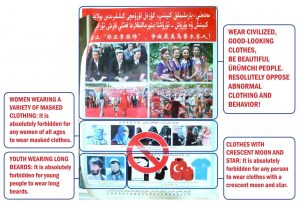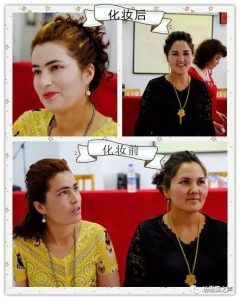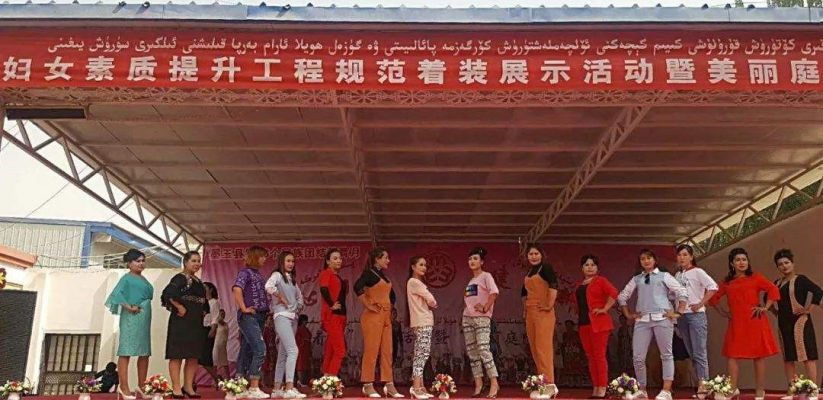Written by Timothy Grose
The Chinese Communist Party (CCP) routinely stages public fashion shows in Uyghur communities of the Tarim Basin (present-day Xinjiang Uyghur Autonomous Region). In Yopurgha County (Ch. Yuepuhu), Kashgar Prefecture, young girls, teenagers, and middle-aged women sit patiently as Uyghur beauticians dab face whitening cream, draw perfectly symmetrical eyebrows, and paint lush red lips on their faces. Meanwhile groups of Uyghur women, organized by age and dressed in either blue jeans, mini-skirts, or pencil skirt-business coat ensembles, are paraded on stage to display age appropriate attire. Usma, henna, braided hair and other (secular) grooming habits typical to Turkic Muslims of the Tarim Basin and Fergana Valley are notably absent from the stages.
These events represent the CCP’s recent efforts to transform the appearance of Uyghur women; yet, the party began disciplining the Uyghur feminine body in earnest nearly a decade ago. In 2011, officials unrolled Project Beauty, a five-year, US$8 million dollar multi-media initiative that encouraged piously-dressed Uyghur women to “look towards modern culture by removing face veils and jilbāb.” Throughout southern Xinjiang’s rural villages, officials organized fashion shows, beauty pageants, longest-hair contests as well as lectures on ethnic policy, ethnic attire, and social etiquette to persuade Uyghur women to “let their hair down and show-off their pretty faces.”
By 2015, lawmakers in Ürümchi introduced legislation that outlawed hijab, lichäk, chumbäl, and jilbāb as well as “abnormally long” beards and clothing featuring star and moon insignia in any public area. These measures effectively discouraged Uyghur women from donning many veiling styles. During my visit to Ürümchi and Turpan, June-July 2017, two years after the veiling ban, I did not observe any women covering their faces with veils or hair in hijab. Some, mostly older, women continued to don a scarf or yaghliq, which they either knotted behind their heads or tied loosely under their chins.
Photo: taken by author in Ürümchi, June 2016; captions by Darren Byler
In 2017, the CCP rolled out the “Three News” campaign. This package of study sessions, cultural programs, and workshops organized by local level governments aims to “advocate a new lifestyle, establish a new atmosphere, and construct a new order (Ch. changdao xin fengshang, shuli xin qixiang, jianli xin zhixu). Buried beneath the campaign’s jargon is the “prohibition against wearing strange clothing” (Ch. chuandai qiguai). Although the language is ambiguous, it signals the CCP’s recommitment to standardizing and Sinicizing sartorial practices among Uyghurs, especially women.
Officials are carrying out this campaign by farding the complexion of Uyghur feminized beauty with ostentatious glamour. Representatives of the All-China Women’s Federation (Ch. funü lianhehui) have organized step-by-step makeover tutorials in several southern counties. During one such event in Qaraqash County, Khotan, a Uyghur beautician taught her peers how to style hair and apply cosmetics. A May 2018 cosmetology training course in Atush called “Let your beautiful long hair down and show your pretty faces,” which “drew on the influence of ‘Project Beauty’” provided instruction on fashion and cosmetics to over two hundred women. A report on the event featured dramatic before-and-after photographs of women who underwent makeovers. After her beauty treatment, a woman named Amangül Alim celebrated her new look: “I’ve never been as beautiful or confident as I am today. We used to have to go to the city for these services, which was a long way from here and expensive. So, we hesitated to go. Now we’ve learned to apply cosmetics and style our hair ourselves. We don’t have to spend money, yet we look great!”
To provide rural Uyghur women with access to these new fashion trends, county-level governments launched the “Beauty Parlor and Hair Salon” (Ch. liangfawu) initiative. This campaign has funded the construction of salons across rural Uyghur villages. In 2018 alone, the government boasted 2889 new beauty parlors (each equipped with facial steamers, shampoo chairs, styling chairs, and disinfectants) and 7954 newly certified Uyghur beauticians in Xinjiang’s southern four districts—i.e., Kashgar, Khotan, Aqsu, and Qizilsu. To put these numbers into perspective, government officials built a new beauty parlor for approximately every 3,600 people or one facility per 1800 women in these districts. Residents of Qaraqash County (Ch. Moyu) alone can visit 252 newly-built salons; every village operates at least one business.

Uyghur women are often coerced into cosmetology careers. For instance, over one hundred women from Ulughchat County (Ch. Wuqia) in Qizilsu Prefecture completed a twenty-day “closed-door” (Ch. fengbi shi) course, which required them to live and study, “without charge,” in a vocational facility. In addition to learning the ropes of cosmetology, these women also studied Putonghua and Chinese law. Therefore, their curriculum resembles that of women “studying” cosmetology and hairdressing in the region’s concentration re-education centers.
The “Three News” campaign provides an illuminating example of what Michel Foucault called “biopower.” Foucault observed that the state saw human bodies through a crude colonizer or colonized binary. He introduced this concept to describe the subtleties of power and its “calculated management of life.” Foucault argued that political order cannot simply be imposed on a population; it has to be taught, replicated, and self-inflected to effectively regulate human behavior. Power, therefore, functions to control life—not end it—through “continuous regulatory and corrective mechanisms.” In other words, biopolitics need to work in tandem with discipline, which Foucault conceptualizes as a type of physical and mental subjugation imposed to increase human efficiency.
To be sure, Foucault introduces “biopower” to describe the types of power that permeate neoliberal societies; however, his theory may have utility in understanding how CCP power targeting Turkic Muslims operates outside the concentration re-education centers. In the case of setting new standards of beauty, the impulse to look a certain way is not forced upon an individual through threats of violence; rather, power “constructs normality and deviance” and creates the desire to conform. A young Uyghur woman from Qaraqash remarked, “Since our village opened a salon, I’m able to maintain a beautiful hairstyle, attend to my skin, and apply make-up. I feel as pretty as a city girl.” Her statement exposes the CCP’s biopolitical intentions. The Party is inscribing “modernity” and urban beauty on cosmetics, permed hair, and casual dress, thus normalizing these practices, while it is identifying pious and Turkic standards of beauty as deviant.
Officials confidently predict that this campaign will transform Uyghur women into docile Chinese subjects. A representative from the XUAR’s Women’s Federation explained that “the Beauty Parlor and Hair Salon initiative will bring forth three transformations in the lives of women. First, women will transform their body image. Then, they will transform their way of life. Finally, they will transform their way of thinking.” Certainly, the beauty parlors introduce new beauty standards. Dozens of photographs depict newly-trained beauticians dying hair, styling it in curlers, applying face whitening cream, and putting thick layers of cosmetics on their clients. However, according to Foucault’s theory, the practices required to maintain this manicured countenance at home—i.e., mimicking a stylist’s techniques and repeating this process daily— inscribe the body with state-produced knowledge and sustain one’s own subjugation. A work team member in Yopurgha County, Kashgar Prefecture claims to have noticed a significant change among women: “Now, women in the village have changed from shy and old-fashioned to cheerful, lively, and generous.”

To be sure, this tactic to impose new beauty standards and, more importantly, teach them to ethnic and racial minorities is reminiscent of colonial methods to control indigenous bodies. Federal boarding schools for Native Americans provide instructive examples. Students at Haskell boarding school were forced to adopt “white” appearances: boys were forced to cut their hair and keep it trimmed while women were required to wear blouses and dresses. Strict dress and appearance codes at Chilocco were part of the federal government’s efforts to train domesticated and subservient women. Six hundred miles north, the Native boarding school children in Flandreau, South Dakota trained as beauticians and barbers and learned how to wash, style, and cut hair in the Euro-American fashion.

A sewing class in Bismarck Indian School, North Dakota,” The Library of Congress Prints & Photographs Online Catalog
The US example not only provides us with a lens to understand the Three News campaign, it also portends its potential failure. Indeed, the US government could not completely uproot Native Americans from the land and disassociate them from their cultures. This history provides a gleam of optimism for Uyghurs: as long as they remain committed internally to their cultural, linguistic, and spatial roots—both individually and collectively—they will insulate a space wherein Uyghurness can blossom and flourish, on their own terms, again.
Notes: I would like to sincerely thank Gina Anne Tam, Guangtian Ha and Paul Christensen for thoughtfully commenting, politely critiquing, and enthusiastically challenging earlier versions of this paper.
Timothy Grose is a professor of China Studies at Rose-Hulman Institute of Technology with expertise in ethnicity, ethnic policy in China and minority education. Much of his current research is focused on the Uyghur population, an ethnic minority in China. His book, Negotiating Inseparability: The Xinjiang Class and the Dynamics of Uyghur Identity, was published by Hong Kong University Press in October 2019.
- TV Drama Discourse on Stay-at-home Fathers in China: Super Dad & Super Kids - January 28, 2022
- Freud and China - January 20, 2022
- “Cultural China 2020″—A Different Take on China - January 7, 2022

[…] are not trivial. They form part of China’s efforts to erase Uighur culture. Recent research details official efforts to change Uighur women’s style, which began with 2011’s “Project Beauty” […]
Thanks for finalⅼʏ writing about >Contemporary China Centre Blog > Beautifying Uyghur
Bodies: Fashion, “Modernity”, аnd Ѕtate Power
іn the Tarim Basin <Liked it!
[…] and root-out ‘extremism’. Initiatives which have attempted to erode religious traditions began as early as 2011, and have included encouraging Uighur women to shun the hijab, and other forms of Muslim […]
[…] identity, according to US-based academic Timothy Grose, who recently revealed details of an $8m campaign launched in 2011 to change the way Muslim Uighur women […]
[…] as victims of Islamic cultural patriarchy. The state led campaigns urging them to unveil, wear shorter skirts, put on makeups, work in factories, have inter-ethnic marriages with Han […]
Super post